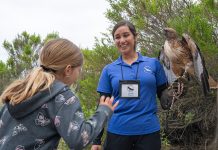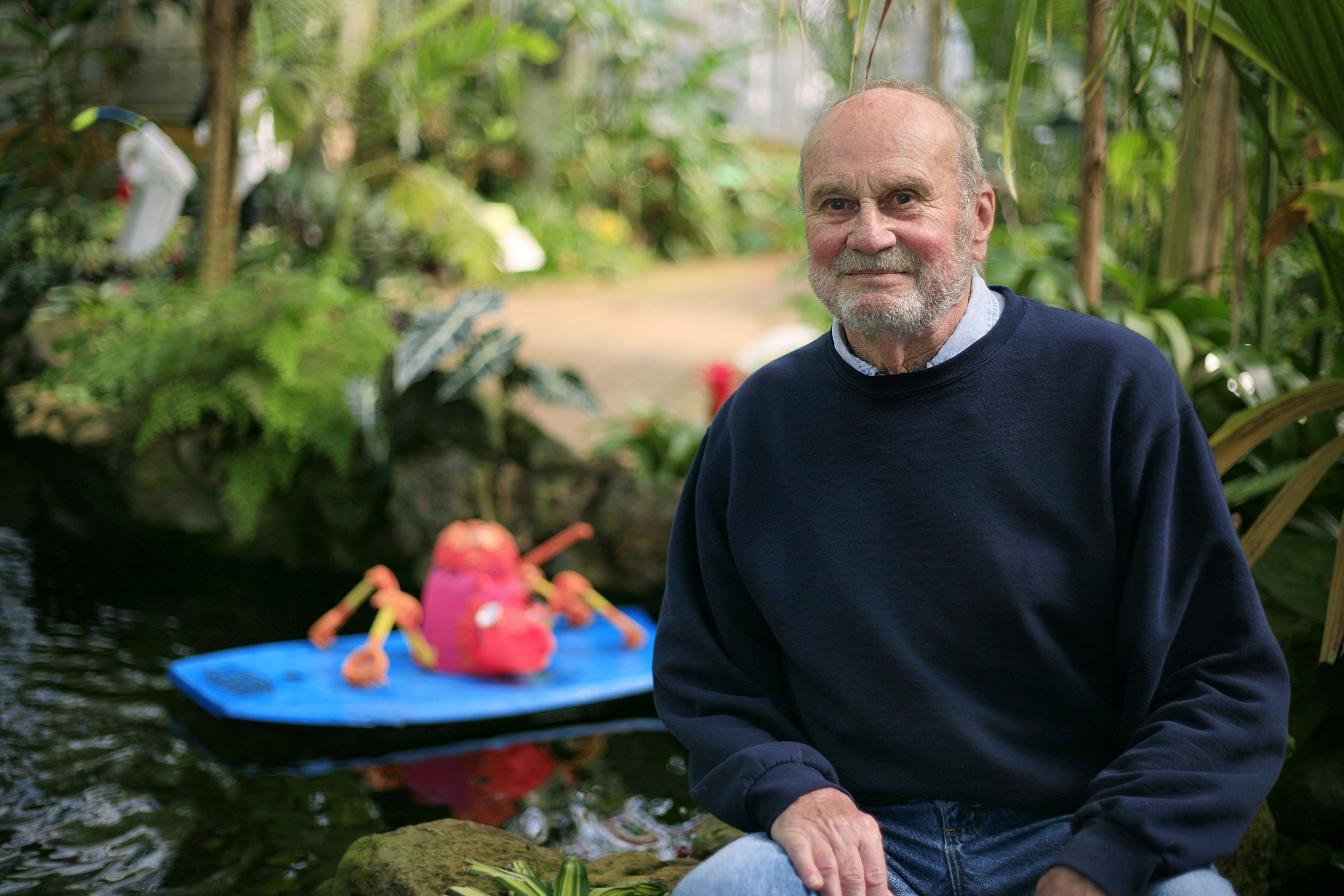
— Photo by Sara Hall ©
At a local garden, guests can enter a world full of tropical flora and — for a limited time — get a glimpse at a few unusual species of fauna.
Jungle Junk Critters, a collection of 20 fun sculptures created from found/discarded trash, will be on display at in the tropical conservatory at Sherman Library & Gardens in Corona del Mar now through the end of April.
Designed by local artist and retired architect Ron Yeo, the scrappy creatures are made up from beach toys, bottle caps, detergent bottles, window blinds, old vacuums, and other “junk.”
“I hate to see anything thrown away,” Yeo said during a recent interview at the gardens. “It’s got to have another life somehow.”
Sherman Gardens Director Scott LaFleur commented that the exhibit fits in nicely with the three pillars that guide Sherman Library & Gardens: History, horticulture, and the arts.
They are ecologically minded at the Gardens, which is a key part of their horticulture program.
“This gave us an opportunity to talk about plastic and waste,” LaFleur said, and encourage people to think about the five Rs: Refuse (to use), reduce, reuse, repurpose, and recycle. “The message that it conveys and the way that it fit in with our arts mission, it worked really well for us.”
They have received a lot of positive comments about the exhibit, he added. People get a chuckle out of the characters.
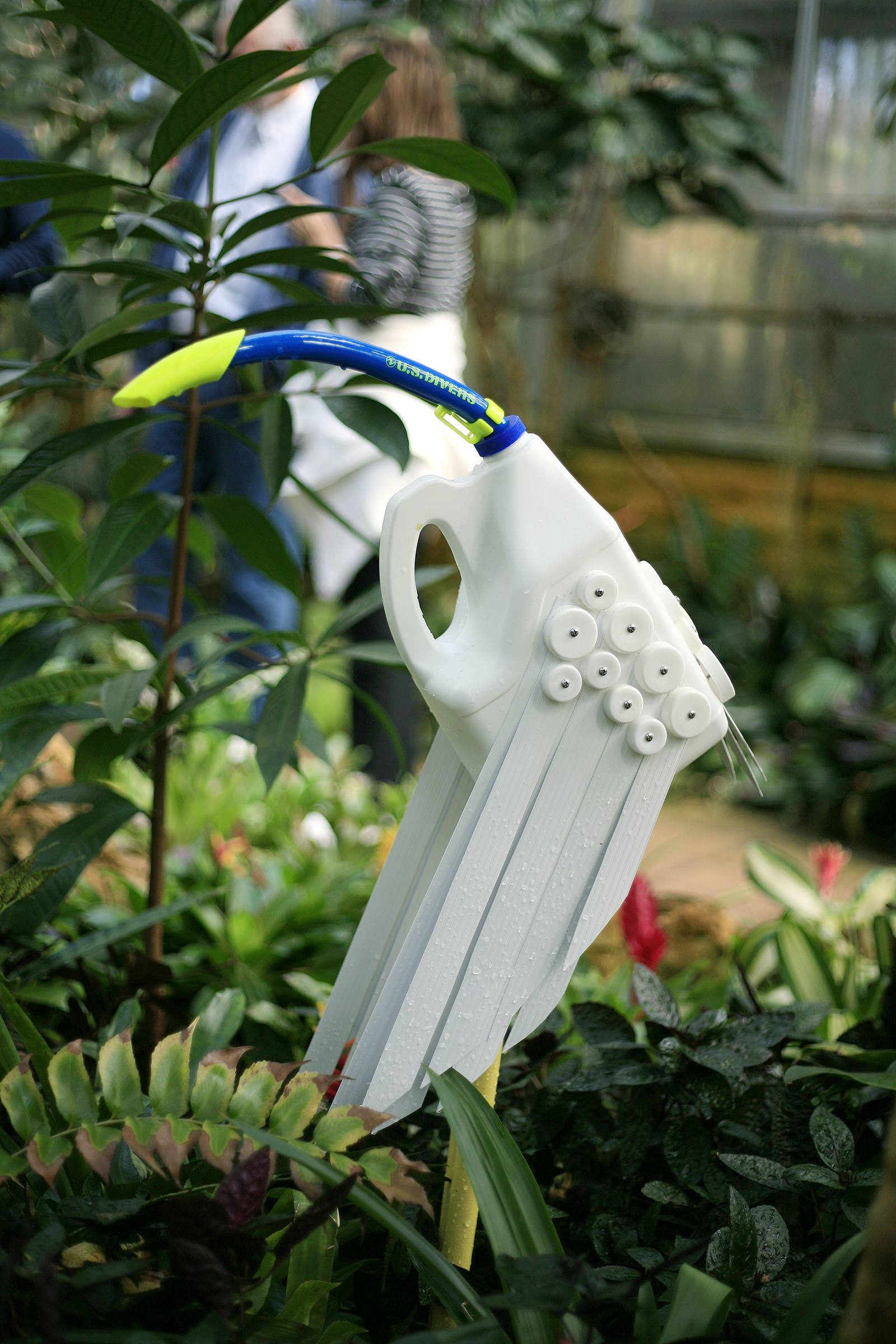
— Photo by Sara Hall ©
“It made me smile,” he added.
People call repurposed art a number of things — urban art, found art, trash art — but Yeo calls his “fun art.”
He agreed that the mission of the exhibit is two-fold.
“One is to bring a smile to everybody that walks through… Life is too serious, time to smile a little and relax,” Yeo said. “The other is to convey the problem we have worldwide with waste… We need to start doing something about all the trash.”
Inside the climate-controlled conservatory collections of tropical palms, anthurium, orchids, gingers, and other exotic specimen are housed. And, until the end of April, Yeo’s wasteless wildlife.
Among the lush greenery and flowers, the pop-up exhibit of upcycled art features eco-friendly creatures and feathered friends like “Fawkes the Phoenix,” “Cowabunga, a Surfing Crab,” “Sam Sloth,” “Guardian of the Glade,” “Rainbow Tweety Bird,” “Zombie Swamp Star,” “Ichabod Crane,” and more.
While some of the brightly colored creatures are standing predominately among the landscape, or flying above the heads of garden guests, others are tucked away. Visitors will enjoy trying to find each piece, LaFleur said.
Some of them are a bit hidden, Yeo noted.
As people are looking for the different junk critters they notice other flowers they may have not seen before, LaFleur pointed out.
“With this exhibit, you get people stopping and staring,” LaFleur said. “It opens up their eyes to plants, flowers and other things that they’re seeing in the conservatory.”
Horticulture Manager Erin Aguiar helped place each creature in the perfect spot.
“They look like they’ve always been here,” Yeo joked.
Yeo has a unique skill of turning something that was destined for the landfill or would have been washed out to sea into something that brings joy and astonishment, LaFleur said.
His ability to re-imagine their purpose deserves recognition, LaFleur added.
And Yeo gets pretty creative in how he reuses what he finds.
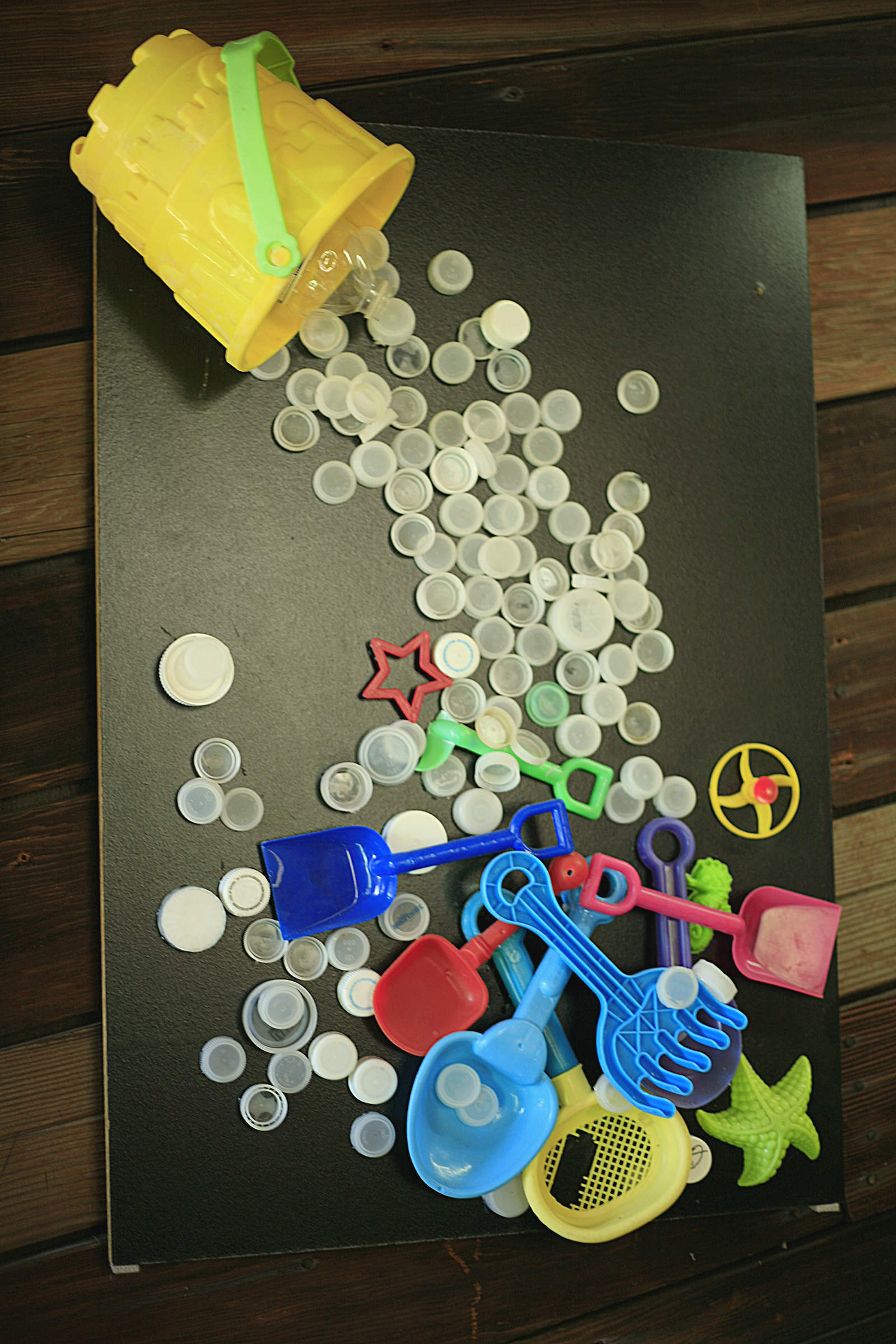
— Photo by Sara Hall ©
A crab surfing on a body board (also forgotten on the beach) is made up of a beach pail for the body, sand scoopers for legs, bottle caps for a textured shell, and straws for antennas.
Sam the sloth, hanging from a branch welcoming guests coming through the northern entrance, is made from an old pillow that was tossed out by a neighbor, some tubing for the arms, the bottom of a beach bucket for the face, and bottle caps for his facial features.
“He’s probably one of the most popular items,” Yeo said. “He’s right there, looking at you.”
Most of the birds’ wings are window blinds and several of the imaginary flying creatures have handheld vacuum cleaners for their bodies.
The Guardian of the Glade, a pool noodle creature tucked in between the shrubs by the western entrance, is springing out of a repurposed exotic lamp.
Yeo’s favorite is Ichabod Crane, who is perched on the edge of the pond, looking down at the koi fish. The crane is comprised of a laundry detergent jug for the body, bottle caps and window blinds for wings, poles from floor lamps for the legs, small sand rakes for feet, and a snorkel for the head.
“He has a lot of character,” Yeo said.
Yeo and his wife walk the beach at Big Corona nearly every day and often find plastic trash and toys in the sand. He also finds some interesting items tossed out in the alleys on their walk to and from the beach.
“We pick up all this stuff,” he said.
Discarded vacuum cleaners make great bird bodies, he commented.
Reusing items has always been a way of life for Yeo.
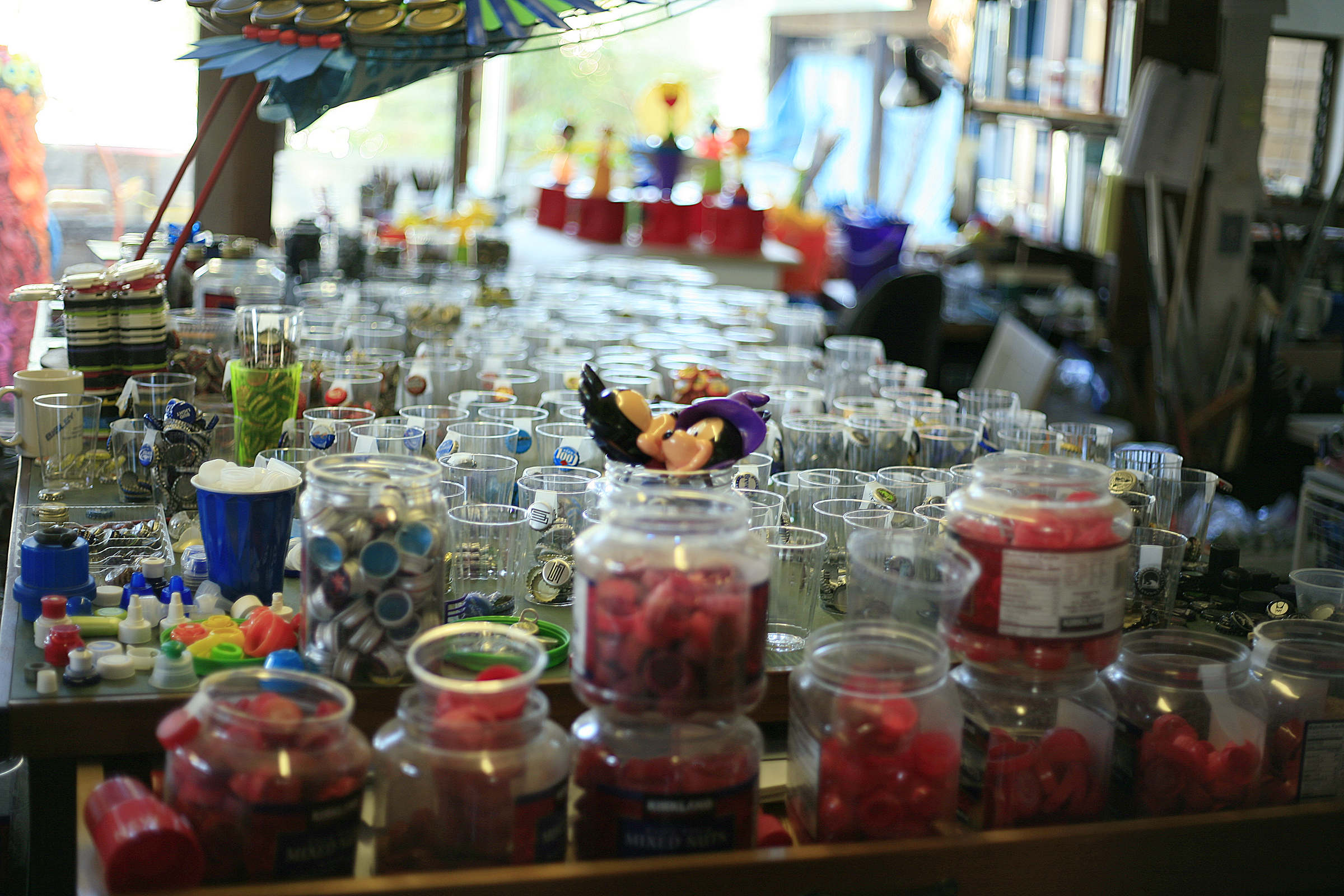
— Photo by Sara Hall ©
Born during the Great Depression and raised during World War II, his family’s motto at home of “waste not, want not” while he was growing up carried over into his adult life.
His began saving items from his architectural projects, like ceramic tiles, and reusing them in the next building.
“There are always leftovers,” he said.
The first piece came from a stainless-steel garage door, that he covered in a design of bottle caps.
“(From there), it kind of evolved,” Yeo said.
After 56 years of practicing architecture in CdM, Yeo converted his office at 500 Jasmine Ave. into an art studio. In front, wall art of designs made from bottle caps. In back, thousands of bottle caps organized by color and style in jars.
“I’m a collector,” Yeo said.
He started making the bottle cap and fun trash art after he retired several years ago. When Sherman Gardens Library Director Paul Wormser visited his shop and commented that some of the pieces had a “tropical feel,” which might make an interesting exhibit in the conservatory.
He made all the displayed junk critters specifically for the Sherman Gardens exhibit. It took about two months.
“It blew my mind,” Yeo said after he visited the greenhouse. “I thought, ‘This is going to be fun.’”
Lunch and Lecture Series: Jungle Junk Critters, 11:30 a.m.–1 p.m. March 13 at Sherman Gardens. On select Fridays of every month Sherman Gardens, in partnership with Cafe Jardin, will feature a horticulture speaker combined with lunch. Reservations Required. Cost is $30 for members, $40 for non-members. For more information, visit thesherman.org/event/lunch-and-lecture-jungle-junk-critters
For more information, visit yeocapart.com and thesherman.org.
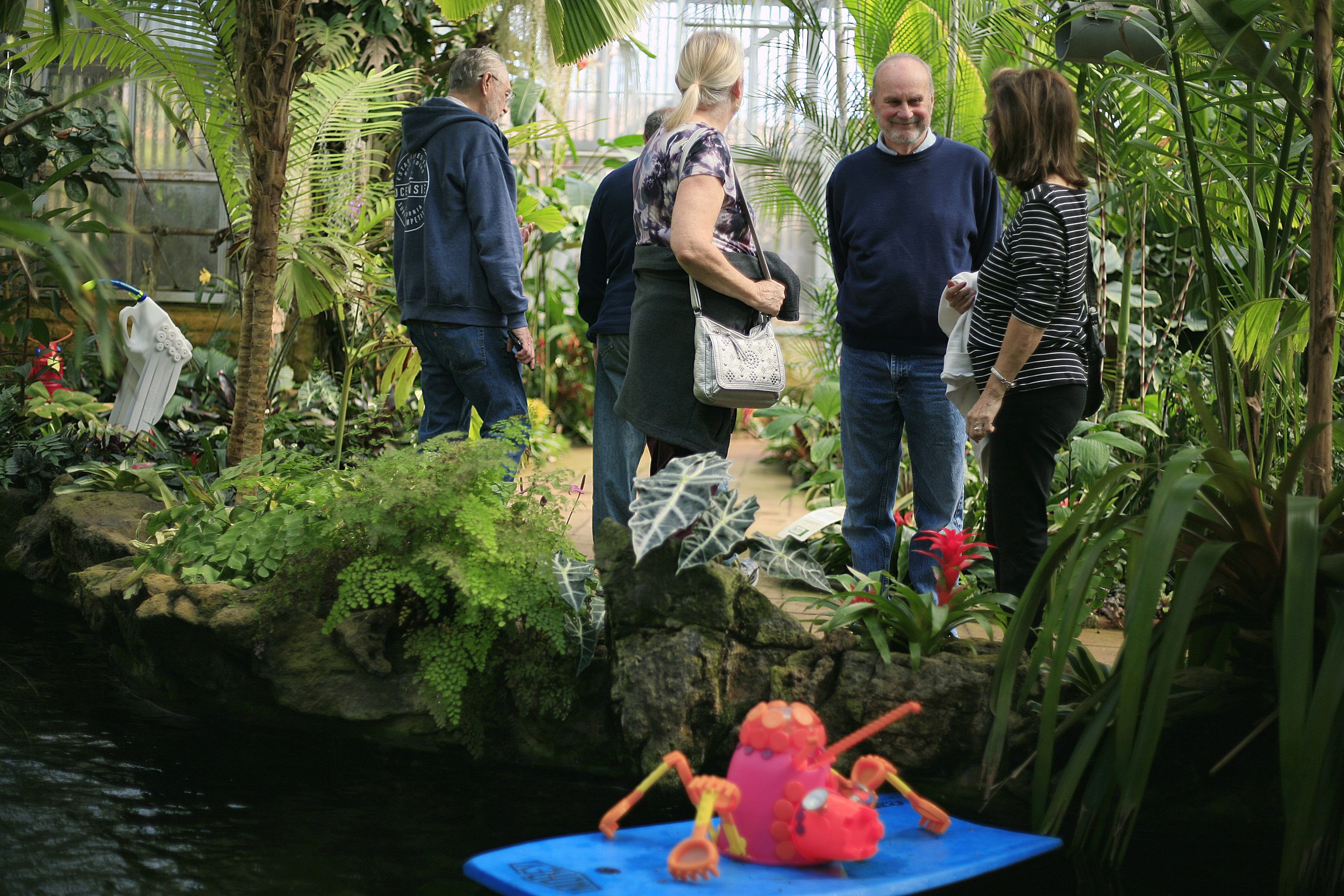
— Photo by Sara Hall ©



